Project managers love a good plan. It takes what might be an overwhelming project and structures it in such a way it can now be methodically executed. Everything is within control. It might sound boring, but stakeholders are not buying a ticket for an amusement park thrill ride, they just want the job done right.
That’s why several project management methodologies such as waterfall, agile, kanban, critical path method (CPM) and critical chain project management (CCPM) have been created over time to help teams manage their work. There are overarching methods and those that focus on specific aspects of a project, such as scheduling and monitoring. Every project phase is important, but perhaps the most critical to a successful end is the planning and managing of resources.
Resources are more than just the equipment you use or the site on which the execution of the project takes place. Resources include your team. People, places and things – that’s a lot of balls to juggle. Think of it as a critical chain. In fact, there’s a methodology to control project resources. This is Critical Chain Project Management (CCPM).
What Is Critical Chain Project Management?
At its core, the critical chain method plans the execution of project tasks and the allocation of project resources. Executing tasks that make up a project requires resources, including people, equipment materials, locations and more.
While critical chain might sound similar to other project methodologies, such as critical path and the Project Evaluation and Review Technique (PERT) algorithm, it is different. Task order and a rigid schedule are the hallmarks of traditional structure.
Critical chain project management was developed by Israeli business management guru Eliyahu M. Goldratt, who also invented the theory of constraints, which works to keep project resources level. This involves more flexibility with the start time of project tasks.
The theory of constraints is the foundation of CCPM. A small number of constraints help management systems achieve more goals. Think of it like the adage that a chain is only as strong as its weakest link.
ProjectManager’s Gantt chart allows project managers to allocate resources for each task, estimate costs, and compare those estimates against the actual project costs to keep track of the critical chain. This project data can also be shown in kanban boards, project dashboards and reports. Get started with ProjectManager today for free.
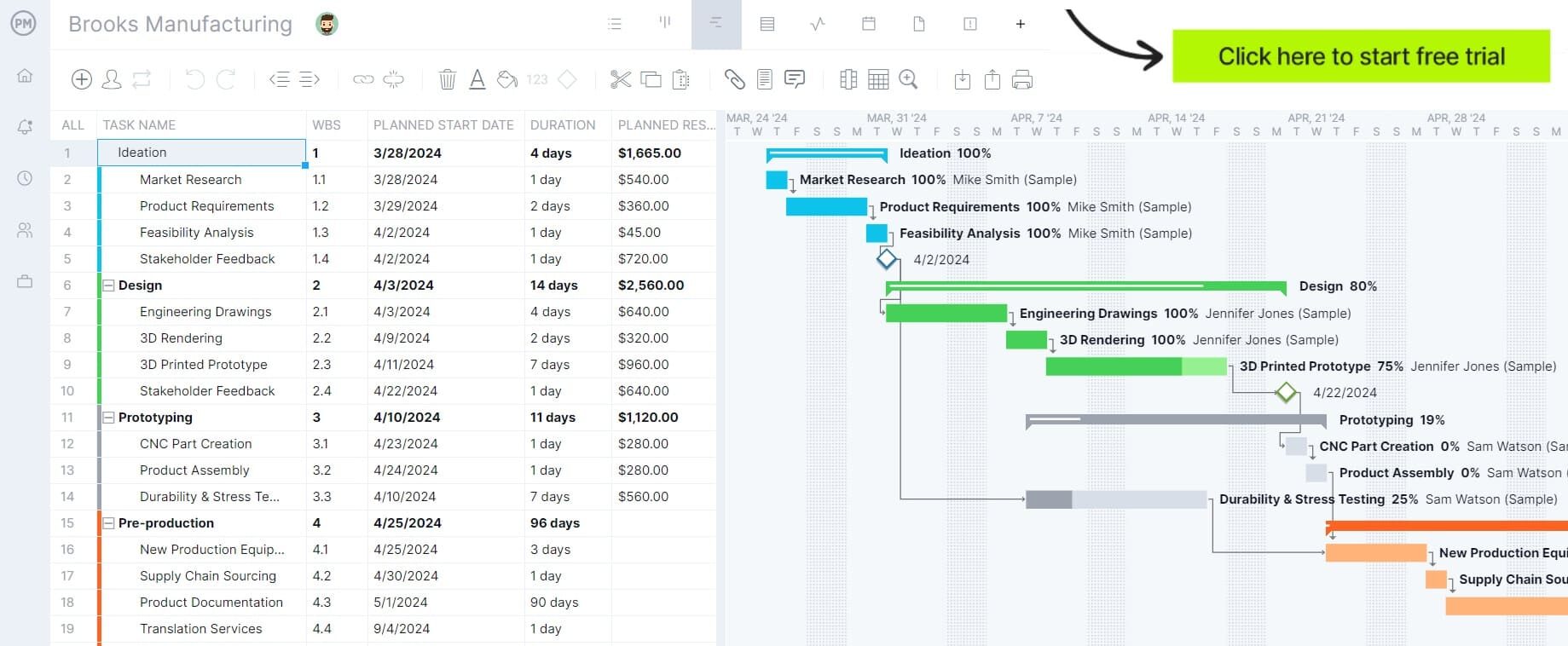
What Is the Critical Chain of a Project?
The critical chain is composed of several elements that can be identified within a project schedule, the critical path, feeding chain and buffers of a project schedule.
To visualize them you’ll need to use a Gantt chart, which is the main schedule graphing tool in the critical chain project management method. We’ll review these elements in our critical chain example below, but first, let’s define what they are.
Project Tasks
The critical chain scheduling method attempts to push the limits of project teams by allocating the minimum time possible for the execution of tasks, to eliminate any idle time within the duration of tasks known as float or slack in project management. After scheduling tasks like this, it will be easier to identify the critical path and feeding chain of the critical chain project schedule.
Critical Path
The longest sequence of tasks in a project, process or workflow is based on their estimated duration, task dependencies and the resource availability of the organization.
The tasks in the critical path can’t be delayed, they must be completed in time, or else the project timeline will need to be expanded past its original completion date. However, the critical chain project management method helps overcome this project planning challenge, thanks to the project buffer at the end of the critical path activities.
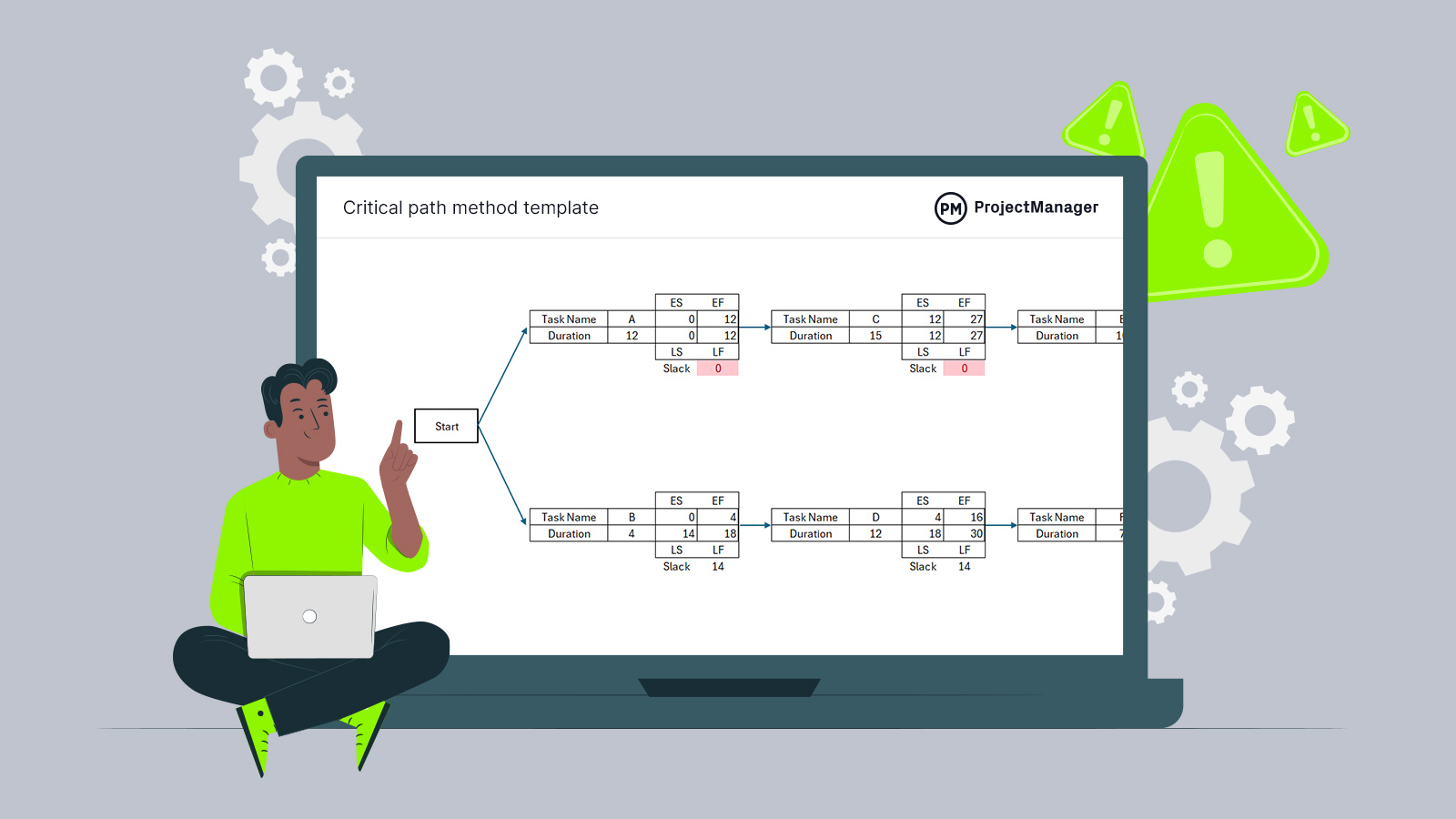
Get your free
Critical Path Template
Use this free Critical Path Template for Excel to manage your projects better.
Feeding Chain
The feeding chain is the sum of project tasks that aren’t in the critical path but are still needed to complete the project. The main difference between the feeding chain and critical path tasks is that the feeding chain tasks have a feeding buffer, which is the time that project management teams can delay their completion without affecting the duration of critical path activities.
Project Buffer
Because of the strict project scheduling approach of the critical chain project management method, it’s expected to have unfinished work at the end of the project timeline. One of the most distinctive aspects of critical chain scheduling, a project buffer is a period, usually about a third of the length of the project timeline, which is allotted at the end of the project timeline so that the project team can complete unfinished tasks.
Critical Chain Schedule Example
The critical chain schedule below shows a project schedule for a residential construction contractor, who will build a house for a client.
This project schedule was created using ProjectManager’s Gantt chart, which shows the duration, project buffers, dependencies and percentage of completion of each task in a visual timeline. In addition to this, ProjectManager’s Gantt chart automatically identifies the critical path of the project.
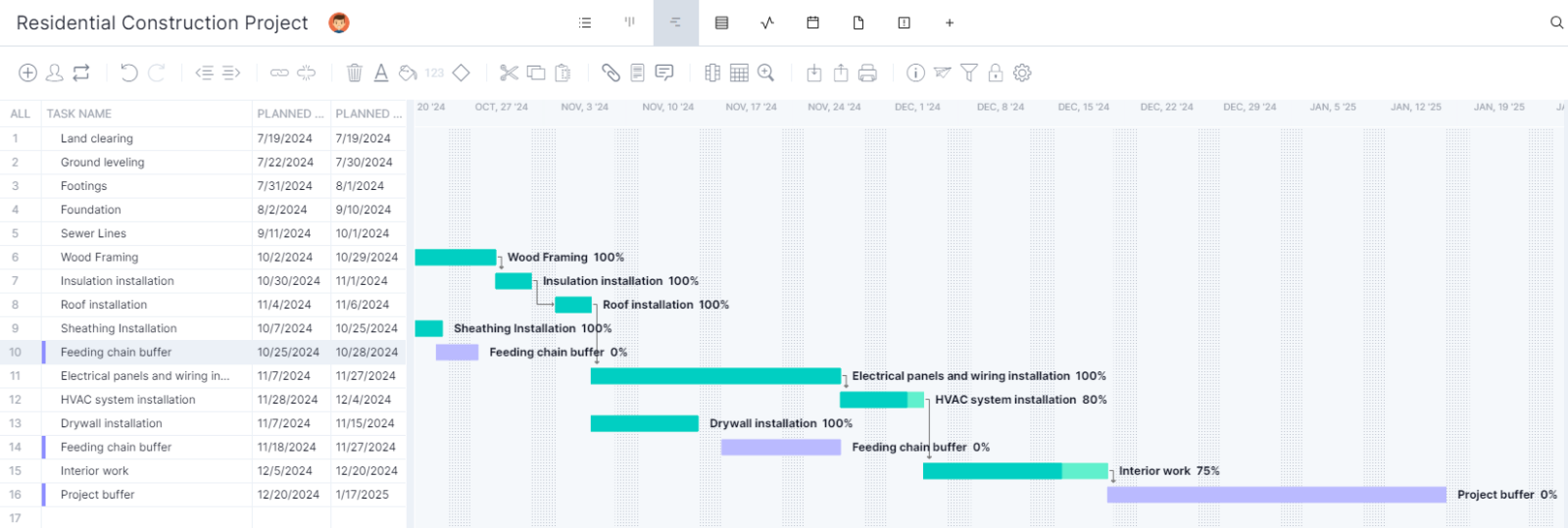
Critical Path Method (CPM) vs. Critical Chain Project Management Method (CCPM)
Because of their names, these two concepts are often confused and even used interchangeably by some project managers and non-project management professionals, but this is far from the truth, as these are two distinct project scheduling methods.
There are two main differences between them. First, as we just discussed, the critical path of a project is not the same as the critical chain. A critical chain of a project is made up of its critical path, project buffer and feeding chain. The critical chain scheduling method uses the project buffer and feeding chain buffers as a workaround for ensuring critical path activities are completed on time.
The second key difference between these methods is the use of buffers, which is unique to critical chain project management. This notion doesn’t exist in the critical path method. While they might seem subtle, these two differences drastically vary the functioning of these two similar project scheduling methods.
How Does the Critical Chain Method Work?
Goldratt, who literally wrote the book on Critical Chain, was on a mission to make projects finish quicker and cheaper than by traditional methods. When he wrote the book, in 1997, a study by the Standish Group found that only 44 percent of projects were able to close as scheduled, and even then they finished over budget and fell short of planned scope. Many (30 percent) never made it to completion.
The presence of resource-dependent tasks often slows projects. The critical chain includes these tasks, in sequence. Therefore, the critical chain is no different than the critical path, assuming resources are available and unlimited.
Ineffective methods – including the following – lead to schedule uncertainty:
- Padding task duration
- Starting work as early as possible
- Multi-tasking
Critical chain identifies resource dependencies and is happy with “good enough” as time is spent trying to find the best path forward.
Critical chain project management also identifies and adds project, feeding and resource buffers. Extra time added to keep a project on track is a buffer. Then it monitors project progress through the metric of the consumption rate of the buffers, instead of through the measurement of task performance against the schedule.
Therefore, CCPM uses buffer management rather than earned value management to track project performance. It focuses on the project constraint, as follows:
Critical Chain Management Process
The critical chain project management process (CCPM) is based on the Theory of Constraints model, which improves manufacturing processes. It’s an alternative to traditional task-based project structures and focuses on end goals rather than individual assignments. Follow these steps to implement a CCPM process.
1. Identify Project Tasks
The critical chain can help throughout the project. In planning, start with a work breakdown structure (WBS), only working backward from the completion date. Start each task as late as possible, and add duration for each task.
2. Allocate Resources
Tasks then acquire resources. At this point the plan can level resources, to make sure none of the tasks are taking longer than the longest sequence of resource-leveled tasks from the beginning to the end of the project. This sequence is the critical chain.
3. Estimate the Duration of Tasks
Most tasks are likely going to take longer than their estimated duration. Buffers are used to monitor the project schedule for this reason. The buffer is the difference between the best guess duration of the task, and the safe guess, which offers more leeway. Stakeholders are given a delivery date which is the end of the buffer.
4. Make a Project Schedule and Identify the Critical Chain
Buffers are locked and cannot be altered during the remainder of the project, after the planning phase. This is true for both the scheduling and financial performance of the project. Because there is no slack in the duration of each task, resources are focused solely on the task being worked upon, until it can be completed, and then the next task starts. This process avoids multitasking which can suck up much project time. Think of it as a relay race, each person with the baton is tasked to move as swiftly as they can to hand it off to the next one.
5. Monitor the Critical Chain Throughout the Project
As for monitoring, this is where the rubber hits the road with critical chain project management. Because each task varies in duration from best to safe guess, each task doesn’t necessarily have to be finished on time. Estimates aren’t perfect. Buffers created when planning will be more accurate if the rate of consumption of buffers is low. This means the project is on target. However, if there’s no buffer at the end of the task, that’s a red flag.
Critical Path Method Template
This free critical path method template for Excel can help find the critical path of a project schedule by using the critical path algorithm to identify tasks with zero slack time.
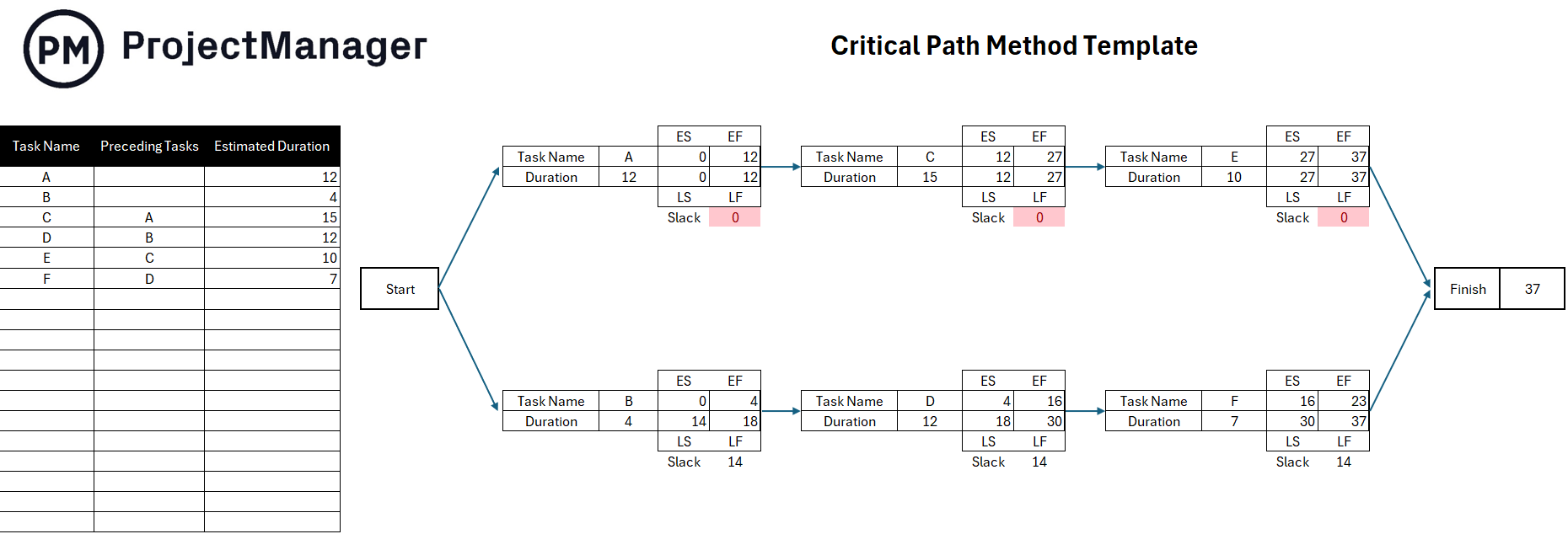
It comes with two task sequences of three tasks each, but it can be edited to reflect any project schedule. Simply copy and paste a task or sequence, edit the arrows and make sure the formulas are edited as they correspond.
Benefits of the Critical Chain Project Management Approach
Many benefits can be obtained from the implementation of CCPM as a project management methodology. Here are some of the most important.
- The project buffer helps project management teams take off the pressure from completing critical path activities by a specific due date, as this time can be used for completing any lingering tasks.
- In most cases, critical chain scheduling increases productivity as it requires tasks to be completed in the minimum time possible. However, it’s important to constantly monitor how tasks are being distributed among team members to keep the workload balanced.
- The project buffer allows teams to review their deliverables and ensure all the project work is completed on time and meets quality standards and acceptance criteria.
- Buffers can help deliver projects on time even when certain tasks take longer than expected or when there’s a low confidence level in time estimates.
How Does ProjectManager Help With Critical Chain Project Management
ProjectManager users can manage resources and keep track of tasks as they are worked on within the software. This ensures resources are accounted for, and monitoring is accurate.
It helps project managers and their teams create and manage tasks online, where they can also collaborate to add productivity:
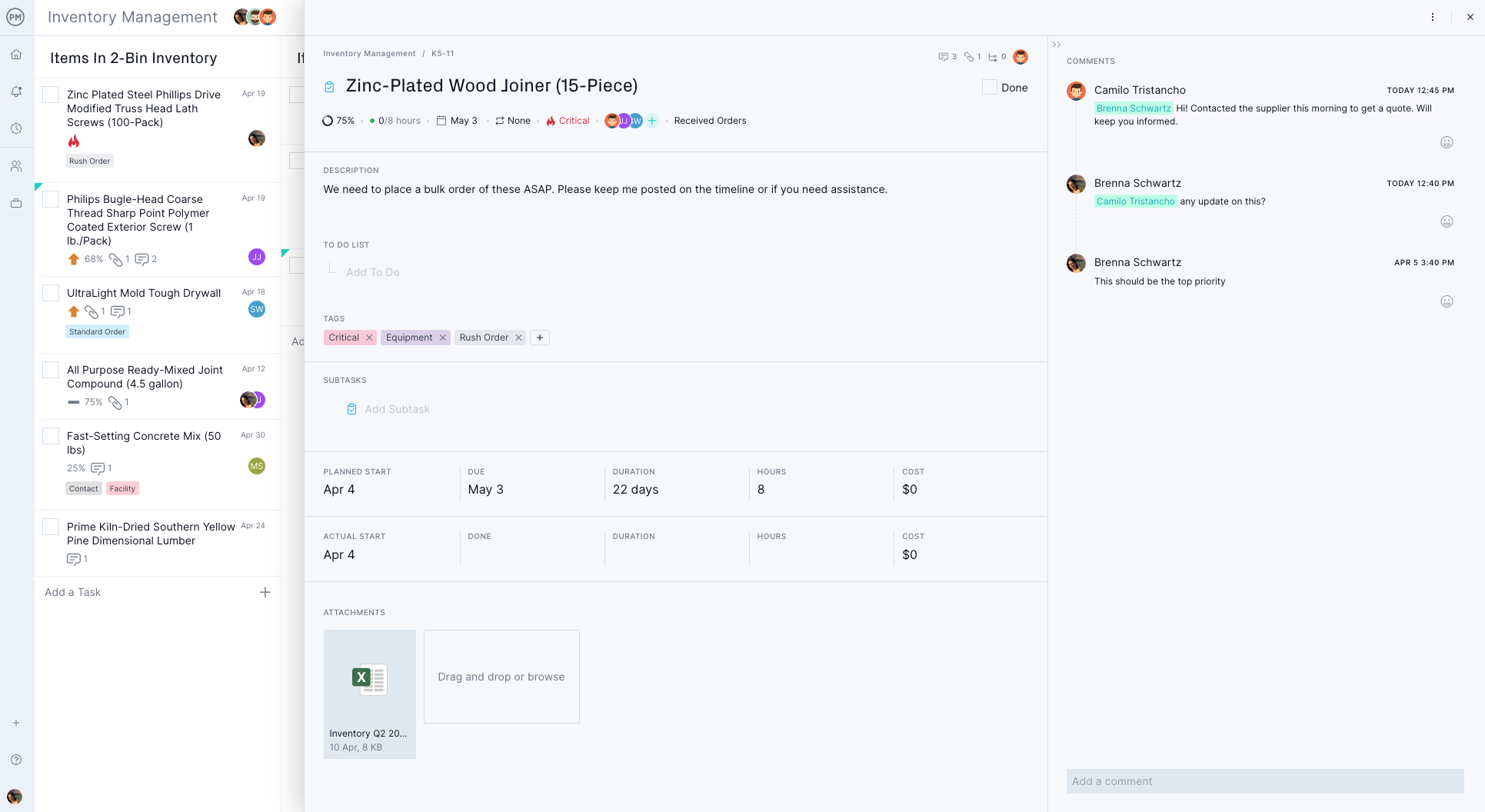
ProjectManager Has Resource and Task Management for CCPM
The task feature on ProjectManager is simple to use but dynamic enough to work across multiple projects. Status updates are real-time because the software is cloud-based. This offers visibility to see where there are bottlenecks or blocks. It also helps to improve delivery.
Each team member has an individualized daily task list they can access for each project they’re working on. This keeps the focus on the work ahead. Just as it is when working with critical chain project management.
As a bonus, each task acts as a platform for team collaboration. Team members can attach notes at the task level, whether images or files and even add comments if there’s a need to ask a question or just hand off the assignment. People are notified automatically when assigned tasks. This keeps production moving swiftly and efficiently. It’s a critical chain best-case scenario.
ProjectManager is online project management software suited for the critical chain, but any methodology you choose to manage your project is supported by our software. It helps with planning, monitoring and reporting, and the real-time dashboard gives you all project metrics on one page. It’s easy to filter the dashboard to show just the information you need. Try it today with this free 30-day trial.

